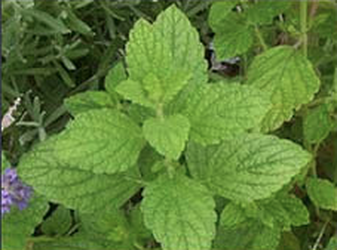
LEMON BALM (Melissa Officinalis)(Perennial) The past several weeks visitors to our gardens have commented on the lemon balm, saying they have a lot and actually consider it a nuisance. It is one of the herbs that grows well locally so it’s very much taken for granted.
Lemon Balm has been used for centuries in Europe for medicinal purposes. The London Dispensary in 1696 cited lemon balm: “Balm given every morning, will renew youth, strengthen the brain and relieve languishing nature”. Its virtue of dispelling melancholy has been praised by herbal writers for centuries. This definitely sounds like an herb we should not be taking for granted.
Like most herbs, lemon balm will thrive in most soils with full sun. It can be started indoors from seed (stone to germinate) or by divisions from friends who should divide theirs every three or four years in the spring or fall. Space plants 30 cm apart
Harvest small leaves to use before the plant blooms. Bunches can be hung and air-dried for use in the winter. When dry, strip leaves from stems and store in a jar away from light.
Suggested uses for fresh lemon balm:
Fresh tea can be made from fresh lemon balm leaves by themselves or combined with mints or china tea. The English Herbalist John Gerard wrote in the 16th century that it “comforts the heart and driveth away melancholy and sadness”. So just imagine a meal like this: barbecued trout wrapped in lemon balm leaves, fresh green salad with chopped lemon balm leaves, fresh carrots with lemon butter, lemon cheesecake with chopped lemon balm leaves in it, decorated with crystallized leaves and lemon balm tea.
At Tansy Lane Herb Farm we use lemon balm in our Kicked Back Evening Tea, Lavender Blue Balm Tea, and our Bath Teas.
I think it’s time for a cup of tea!
Lemon Balm has been used for centuries in Europe for medicinal purposes. The London Dispensary in 1696 cited lemon balm: “Balm given every morning, will renew youth, strengthen the brain and relieve languishing nature”. Its virtue of dispelling melancholy has been praised by herbal writers for centuries. This definitely sounds like an herb we should not be taking for granted.
Like most herbs, lemon balm will thrive in most soils with full sun. It can be started indoors from seed (stone to germinate) or by divisions from friends who should divide theirs every three or four years in the spring or fall. Space plants 30 cm apart
Harvest small leaves to use before the plant blooms. Bunches can be hung and air-dried for use in the winter. When dry, strip leaves from stems and store in a jar away from light.
Suggested uses for fresh lemon balm:
- Stuff chicken with fresh leaves and clove of garlic.
- Make lemon butter for fish dishes or on vegetables. (2 tbsp finely chopped leaves in ½ cup butter, chill or freeze in molds or make butter balls with a melon baller)
- Add fresh sprigs to fruit salads
- Freeze leaves in water in ice cube trays to add to summer drinks
- Whole leaves can be tucked inside the foil pack when barbecuing fish
- Crystallized leaves can be stored for up to a year and used for decorating cakes, cookies etc.
- Every reference to lemon balm includes how wonderful a tea it makes.
Fresh tea can be made from fresh lemon balm leaves by themselves or combined with mints or china tea. The English Herbalist John Gerard wrote in the 16th century that it “comforts the heart and driveth away melancholy and sadness”. So just imagine a meal like this: barbecued trout wrapped in lemon balm leaves, fresh green salad with chopped lemon balm leaves, fresh carrots with lemon butter, lemon cheesecake with chopped lemon balm leaves in it, decorated with crystallized leaves and lemon balm tea.
At Tansy Lane Herb Farm we use lemon balm in our Kicked Back Evening Tea, Lavender Blue Balm Tea, and our Bath Teas.
I think it’s time for a cup of tea!
